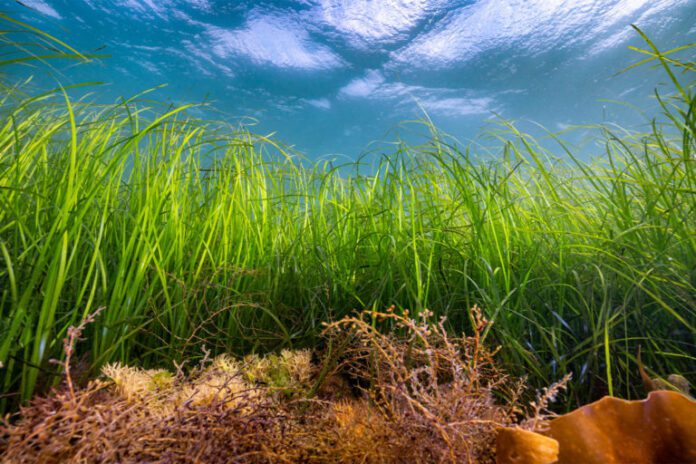- Marine habitats admire mangrove forests, seagrass meadows, salt marshes, and kelp forests quilt factual 0.2% of the ocean floor and supply shelter & meals for myriad existence sorts whereas containing 50% of the carbon sequestered in marine sediments.
- But at a time when the sector wants to attain carbon sequestered to mitigate the results of local weather commerce, about 35% of the sector’s mangroves and 30% of all seagrass meadows had been misplaced or degraded.
- A peculiar op-ed argues that the sector might perchance properly presumably peaceful be shifting to reverse these inclinations: “We’re presently throwing away a golden numerous to deal with the local weather catastrophe, bolster sustainable fisheries and allow wildlife to thrive.”
- This textual content is a commentary. The views expressed are these of the writer, no longer principally of Mongabay.
Blue carbon – the carbon saved in coastal and marine ecosystems – is an unsung ally in our try in opposition to in opposition to the local weather catastrophe. Marine vegetated habitats admire mangroves, seagrasses, salt marshes, and kelp quilt factual 0.2% of the ocean floor, however they rating 50% of the carbon sequestered in marine sediments.
Lets peaceful be prioritizing them, however as an numerous we’re taking a look at them go sooner than our eyes. Roughly 35% of the sector’s mangroves and 30% of all seagrass meadows had been misplaced or degraded over the remainder century. We’re earlier than each a part of an ‘uncouth’ and ‘unparalleled’ local weather catastrophe, and we’re failing to protect the very ecosystems which might perchance properly presumably wait on us avert it.
As an illustration, a Mediterranean seagrass referred to as Posidonia oceanica can sequester carbon at as a lot as 70 cases the tempo of tropical forests. But the hole it covers has shriveled by round 35% over the remainder 50 years, as a result of air air pollution, international heating and unfavorable fishing options.

Seagrasses, kelp, mangroves and salt marshes might perchance properly presumably all wait on us abet removed from runaway local weather commerce if we allow them to. Previous the coasts, whales furthermore retailer mountainous quantities of carbon of their our bodies. A single massive whale can sequester 33 heaps of CO2, which is safely saved on the seafloor when it dies and sinks.
They rating healthful ranges of phytoplankton – which repair carbon from the environment into the ocean – by their faeces, and their migrations circulation vitamins by the ocean.
As quickly as extra, we maintain straight undermined this endorsed local weather mitigation, on this case by a long time of commercial whaling. Restoring eight teams of baleen whale species to their pre-whaling abundance would take tens of hundreds of thousands of tons of carbon out of the environment.
These contributions by myself might perchance properly presumably peaceful be passable to create retaining blue carbon a excessive precedence. Nevertheless, the toughen outfitted by healthful marine and coastal ecosystems goes even further than this.

680 million of us dwell in low-mendacity coastal zones. As we face worsening uncouth local weather, storms and sea stage rises, blue carbon ecosystems can lower the be anxious they motive. Intact salt marshes lower the peak of waves by round 18%, whereas mangroves rating 70-90% of wave vitality.
Blue carbon ecosystems are furthermore cherish troves of biodiversity. Mangroves are dwelling to a transparent fluctuate of species from manatees and dugongs to the endangered Bengal tiger. Mangrove and kelp forests present shelter and meals for juvenile fish, propping up fisheries and livelihoods across the area. In the meantime, seagrasses toughen hundredsof species, and there are over 500 species of plant came upon in salt marshes.
Previous the on the spot advantages to meals safety and livelihoods which come from safeguarding these habitats, many coastal communities maintain deep cultural bonds with them. Hendrik Hermawan, a member of Akar Bhumi, a mangrove planting undertaking in Indonesia, educated us that “planting is part of our tradition and livelihood…after we misplaced the mangroves, we furthermore misplaced our dedication, our spirit and our dignity.” This loss has spurred bid neighborhood course of to reverse it and restore the mangrove forest.
Gape related: Scientists try to revive world’s kelp forests

Mangrove losses maintain slowed critically, going from a yearly practical loss cost of 0.21% between 1996-2010 to 0.04% between 2010-2020. Nevertheless, mangrove quilt is peaceful dramatically lower than it grew to become as soon as within the earlier, and we’re figuring out of time to protect them.
Whereas 42% of the sector’s mangroves are reportedly steady, in Southeast Asia, dwelling to the sector’s greatest quantity of mangroves however furthermore one of many biggest losses, safety charges are totally round 20%. The decline shall be slowing, however we should reverse it.
On the worldwide stage, this spirit of movement is sorely missing. With some exceptions, admire Seychelles’ courageous idea to protect 50% of its seagrasses and mangroves by 2030, these environments maintain largely been left to go no longer infamous. Particularly, filthy wealthy, polluting nations should comply with Seychelles’ lead and commerce course now.
World leaders should resolve to a 30&instances;30 safety idea, retaining 30% of the extreme seas and 30% of nationwide waters by 2030. To be highly effective of the phrase ‘safety,’ this is ready to comprise banning extremely unfavorable fishing options admire backside trawling in any marine steady house.

Leaders can now furthermore house binding and measurable biodiversity targets to flip the Kunming-Montreal World Biodiversity Framework into actuality, and formally undertake and ratify the UN Excessive Seas Treaty. These agreements maintain made a thriving ocean a correct likelihood, however they’re nugatory within the occasion that they create no longer appear to be adopted by sustained movement to place in energy them.
The position of blue carbon ecosystems in combating the local weather catastrophe might perchance properly presumably peaceful furthermore be recognized in nationwide local weather commitments, integrating them into broader efforts to gash emissions and increase carbon sequestration. Native local weather finance can then be outdated to toughen ocean safety and restoration on the neighborhood stage.
Lastly, whereas highly effective of the movement we urgently want is to revive already degraded or misplaced environments, we will stop that destruction from occurring within the first house within the deep ocean. A moratorium on deep-sea mining is critical, combating mining companies from nerve-racking mountainous quantities of carbon which had been increase on the seafloor for tens of hundreds of thousands of years.
We’re presently throwing away a golden numerous to deal with the local weather catastrophe, bolster sustainable fisheries and allow wildlife to thrive. The ocean sustains us all, and its future shall be breeze by how boldly and urgently we act now.
Steve Trent is government director and co-founder of the Environmental Justice Basis.
Banner picture: A seagrass meadow in St. Michaels Mount, Cornwall. Describe courtesy of Lewis Jefferies.
Gape related: A dialogue about seagrass conservation and Indigenous data, hear proper right here:
Podcast: How marine conservation advantages from combining Indigenous data and Western science

